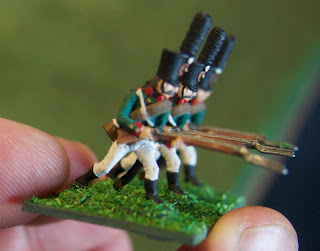It's a gentle lead-in to Leipzig with a mere 110 000–120 000 French-Allied troops and around 80 000 Russo-Prussians. I have just completed the army lists (editing those for Leipzig) and scenario document. The numbers that we will use are:
Army
|
Troop type
|
Approx. numbers
|
No. of figs or guns**
|
French-Allied Army
|
Total
|
118500
| |
Infantry
|
106900
|
2178
| |
Cavalry
|
9600
|
192
| |
Artillery
|
352
|
22
| |
Allied Army
|
Total
|
80400
| |
Infantry
|
54000
|
1080
| |
Cavalry
|
26400
|
528
| |
Artillery
|
380
|
21
| |
GRAND TOTAL
|
198900
|
4236
| |
It should be an intriguing and challenging game for both sides.
Lützen was an encounter battle with Ney's advanced elements (Souham and Girard) initially surprised. Reinforcements steadily came in on both sides so that the villages in the 'quadrilateral' changed hands several times. In the end French-Allied superior command and weight of numbers produced a minor victory that could not be exploited for the lack of cavalry.
The wargame is likely to be a close-fought thing too (hopefully) with the initial Allied attack, French-Allied reinforcements counter-attacking to stabilise the situation, then the bulk of the Allied army countering the counter-attack and finally the advance of the guard and Napoleon's attempted double-envelopment with Bertrand and MacDonald. Will the smaller Allied army, much of it top quality, change history or will the French-Allies be able to do better than their historical counter-parts?
Quite a number of other wargamers and groups have done scenarios of Lützen and they have produced some interesting counter-factual results. There are links to reports of these games on the Wargaming Waterloo 2015 blog. We'll see out how we get on in a couple of months.
An aspect that I found particularly intriguing while designing the scenario was that of the Flossgraben.
Many scenarios of Lützen feature a river flowing from the north, to the east of Lützen, towards Kaja, bending near that town, flowing around Klein Görschen and then south off the board. I wondered for some time what it was as it features on some maps but not others. I finally found a map that had it named and realised that it is the Elsterfloßgraben (Elster float canal). The Flossgraben is “a canal in Saxony and Saxony-Anhalt, built in the 16th century for the transport of wood, branching off from the Weisse Elster River” (Wikimedia Commons, http://commons.wikimedia.org/wiki/Category:Elsterfloßgraben). The photos in Plate 1 and 2 indicate that it is not a serious water obstacle and, if it is to be on the battlefield at all, should be represented merely by a line of trees and bushes (as mentioned in Hofschröer and Hook 2001).
+beween+Kaja+and+Lu%CC%88tzen.JPG) |
| Plate 1: Flossgraben (float canal) shown at left between Kaja and Lützen (district of BurgenlandkreisSaxony-Anhalt) |
 |
| Plate 2: Flossgraben between Kleingörschen and Kaja (Lützen, district of Burgenlandkreis, Saxony-Anhalt) |
I'd be interested in any comments or other points of view on this.
Cited and consulted for the scenario
Chandler, D (1966) Part Fifteen Twilight: The Struggle of Nations, Section 77 Lützen and Bautzen. The Campaigns of Napoleon. Weidenfeld & Nicolson, London. 1993 paperback edition. pp. 881–888.
Hofschröer, P and Hook, C (2001) Lützen & Bautzen 1813: The Turning Point. Campaign 87 (Ed. D Chandler). Osprey Publishing, Oxford, England. 1st edition. pp. 15–58.
Lawford, J (1977) Napoleon: The Last Campaigns 1813-15. Crown Publishers Inc., New York. pp. 30–39.
Nafziger, G (n.d.) French Forces at Gross Gorschen or Lutzen, 2 May 1813. The Nafziger Collection of Orders of Battle, file name 813EAA. http://usacac.army.mil/cac2/CGSC/CARL/nafziger/813EAA.pdf
Nafziger, G (n.d.) Russo-Prussian Order of Battle for Gross Gorschen or Lutzen, 2 May 1813. The Nafziger Collection of Orders of Battle, file name 813ECD. http://usacac.army.mil/cac2/CGSC/CARL/nafziger/813ECD.pdf
Pardo, R (2007) Scenario 32.1: The Battle of Lutzeniki 2nd of May 1813. http://www.rafaelpardoalmudi.com/scenarios/lutzen/Battle_of_Lutzen.pdf
Petre, FL (1974) The Battle of Lützen or Gross Görschen. Napoleon's Last Campaign in Germany, 1813. Chapter VI. First Published 1912. Arms and Armour Press, London, UK. pp. 66–90.

_BorodinoSkirmish.jpg)

















